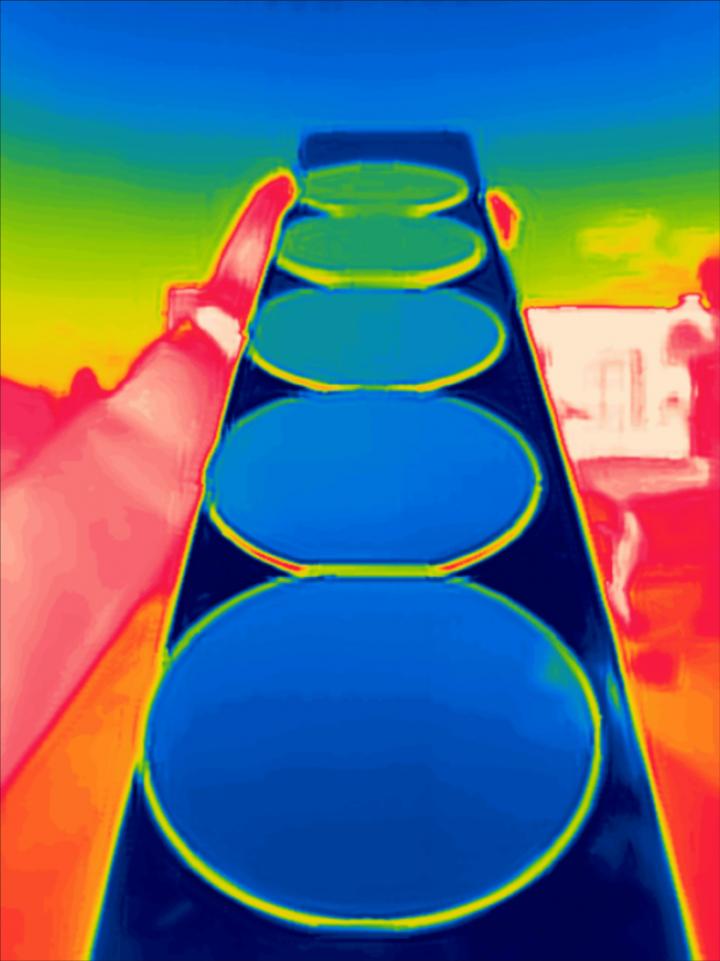UCLA Researchers developed a new class of optical material that can beam thermal radiation to specific directions over a broad spectrum.

Credit: Raman Laboratory/UCLA
UCLA materials scientists have developed a class of optical material that controls how heat radiation is directed from an object. Similar to the way overlapping blinds direct the angle of visible light coming through a window, the breakthrough involves utilizing a special class of materials that manipulates how thermal radiation travels through such materials.
Recently published in Science, the advance could be used to improve the efficiency of energy-conversion systems and enable more effective sensing and detection technologies.
“Our goal was to show that we could effectively beam thermal radiation — the heat all objects emanate as electromagnetic waves — over broad wavelengths to the same direction,” said study leader Aaswath Raman, an assistant professor of materials science and engineering at the UCLA Samueli School of Engineering. “This advance offers new capabilities for a range of technologies that depend on the ability to control the flows of heat in the form of thermal radiation. This includes imaging and sensing applications that rely on thermal sources or detecting them, as well as energy applications such as solar heating, waste heat recovery and radiative cooling, where restricting the directionality of heat flow can improve performance. “
Every object emits heat as light, a phenomenon known as thermal radiation. Familiar examples include the filament in a light bulb, glowing coils in a toaster and even the natural light from the sun. This phenomenon also can be detected on our skin and in common objects — from the clothes you’re wearing to the walls around you.
On Earth, for objects at ambient temperatures to modestly hot objects, much of the emitted thermal radiation resides in the infrared part of the spectrum.
Previously, a fundamental challenge had prevented materials from directing their heat in specific directions over a broad spectrum to ensure a sufficient amount of heat is emitted. To solve the puzzle, the researchers created a new theoretical framework using nanophotonic materials. For the first time, the team demonstrated that this new class of effective materials allows broad bands of thermal radiation to disperse over predetermined angles.
“To demonstrate this concept, we layered several oxide materials, that each manipulate infrared light over different wavelengths, and beamed much of the emitted heat toward the same fixed angles, ” said the study’s first author Jin Xu, a UCLA materials science and engineering graduate student. “Additionally, the oxides we used are common, so supplies would not be a problem in the production of the material. “
The class of materials that directs heat is known as “epsilon-near-zero” or ENZ materials. The researchers call their new material a gradient ENZ material. They demonstrated two such material samples that can beam thermal radiation over broad bandwidths to narrow bands of angles — from 60° to 75° and 70° to 85° respectively.
Using a thermal imaging camera, the radiation angles could be seen looking at silicon wafers coated with the gradient ENZ materials. Viewed from most angles, the heated discs appeared to be cold, similar to how polished metals such as aluminum look under a thermal camera. However, when viewed at the designed specific angles, the higher-heat signatures could be spotted on the discs.
###
The research was supported by the Sloan Research Fellowship in Physics from the Alfred P. Sloan Foundation.
UCLA postdoctoral scholar Jyotirmoy Mandal is the paper’s other author. Mandal is supported by the Schmidt Science Fellows program, a partnership with University of Oxford’s Rhodes Trust.
Media Contact
Christine Wei-li Lee
[email protected]
Related Journal Article
http://dx.




